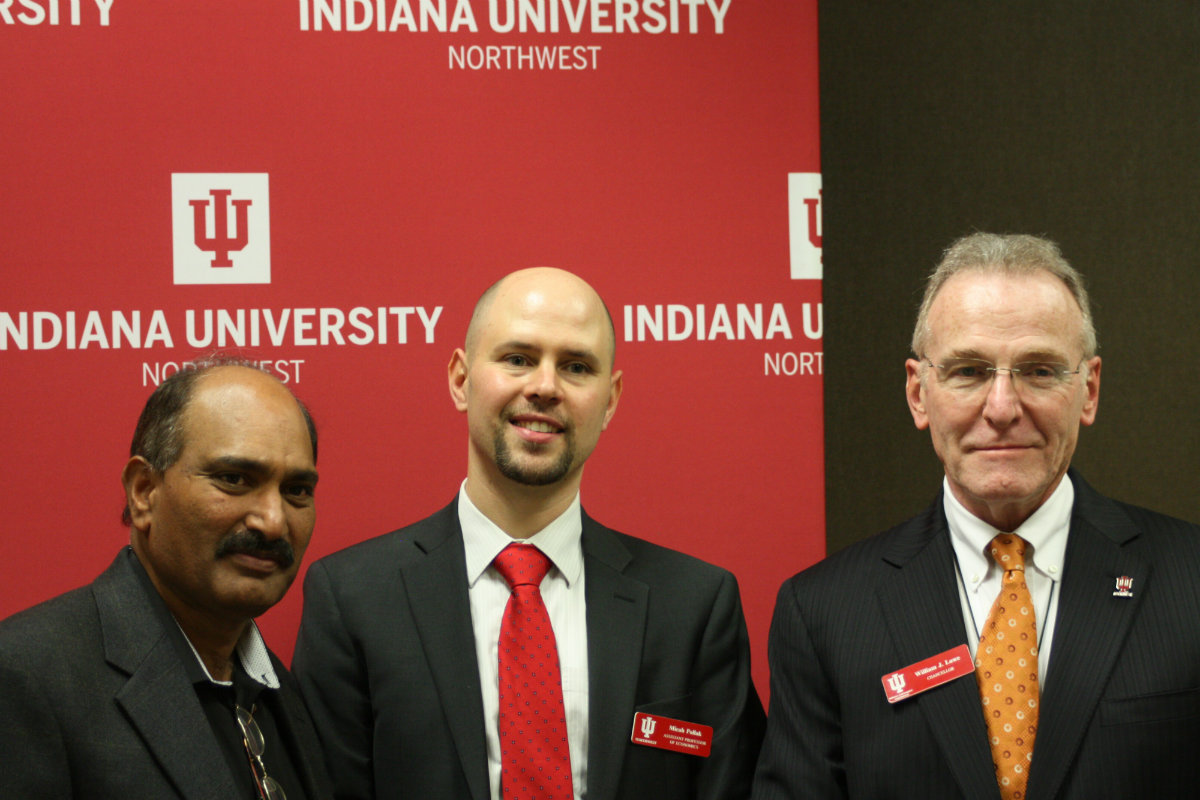Economics is the very heartbeat of the American Dream. From small businesses to city governments, the ability for them to thrive is paramount to fulfilling that dream for anyone in America. We have a unique advantage in our country, in that anyone can start from nothing and build a business around themselves. It is this upward mobility that beckons to people across the globe that want to come to America. So a study of the state of the economy is vital in ensuring that it continues to not only thrive, but grow, so that others can share in that dream that we all aspire to join.
It is for this reason that the Chancellor’s Commission for Community Engagement at Indiana University Northwest is choosing this year to present Drs. Bala Arshanapalli and Micah Pollak’s tool, the Northwest Indiana Coincident Economic Index.
Dr. Bala Arshanapalli and Dr. Micah Pollak, both professors of the School of Business and Economics have spent the last 7 years developing a tool to help identify the underlying measure of the state of an economy. Normally you cannot observe that state because of how complex a society’s economy is. However, the two doctors have managed to come up with a tool to do just that.
They used a variety of economic variables such as employment, retail sales, output, and income to develop a tool that they have dubbed the Northwest Indiana Coincident Economic Index. This tool, along with the more recent supplemental tool, the Gross Metropolitan Product, can disseminate the complex data around a local economy, in this case, the four counties of Lake, Porter, Jasper and Newton, and come up with an easily digestible number that can measure the state of the economy in a timely manner. It’s also a useful tool to help forecast the next six months of economic growth and development.
“You can log on (go.iu.edu/nwi) and see how the economy is doing and it helps fight some of that negative perception that things aren’t growing as fast as we want,” Dr. Pollak said. “It reduces the uncertainty of forecasting the local economy. If you’re a business owner, you can base your business decisions, such as hiring more workers, etc., by using this tool.”
But how does this help the region? Most of the time, economic data, especially on a macro level, such as a state or federal level, takes years to quantify and publish. By limiting the data collected and with the creation of these two tools, Arshanapalli and Pollak have reduced the time needed to collect and publish data down to 1-2 months. Coupled with the fact that they can forecast for the region up to 6 months out, this will greatly help local businesses and politicians tasked with setting policy more accurately.
Chancellor William J. Lowe of IUN said, “We have excellent economic analysis that takes place here at IUN. That’s a great benefit to our students to have a very sophisticated and contemporary tool to look at economic development and growth. It’s also helpful to the region as we think about what the future is going to look like.”
“The presentation was very good,” mentioned Bob Fulton, who works for the City of Hobart as an assistant to the mayor. “A lot of it was information that I had prepared myself for. But I think it’s important to recognize that we have a lot to do and grow from that and this tool will help.”
“The presentation was outstanding,” said Vicky Roman-Lagunas, Executive Vice Chancellor for Academic Affairs at IUN. “I’m proud of the faculty that has put this together. Bala and Micah are consistently presenting to our politiicans, trying to help give a foundation for the decision making that goes on politically. It’s an example of how IUN is really working hard to be a regional institution.”
With the continuing work by these two doctors and the rest of IUN’s School of Business and Economics, it seems likely that they will be able to continue to help the Northwest Indiana economy grow. The benefits of this tool will be passed on to everyone who calls this section of the country home.



